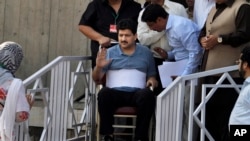Television news channels have sprouted all over Pakistan since former president and military leader Pervez Musharraf opened up the broadcast landscape to private channels in the early 2000s.
Political debates, criticism of the government, and excited anchors shouting every new piece of information as “breaking news” now give the impression of a bold, free, and vibrant media. But many journalists working in Pakistan tell a different story.
“The establishment has almost taken over the editorial policy of most of the media houses,” said Mohammad Ziauddin, former executive editor of the Express Tribune English language newspaper and a journalist with almost five decades of experience. In Pakistan, the word "establishment" is used for the country’s military and its powerful intelligence agency, the Inter Services Intelligence or the ISI.
Attacks in 2014 on two famous Pakistani journalists, Hamid Mir and Raza Rumi, were the turning point that led to this presumed takeover, according to Bob Dietz, the Asia program coordinator at the Committee to Protect Journalists.
Mir suffered six bullet wounds when gunmen opened fire on his car. Rumi was unhurt, but his driver was killed. The attacks, many believed, were supposed to send a message to the larger journalism community.
“The intelligence services sent a really strong message to journalists, and most are toeing the government line at this point,” Dietz said, adding that Pakistani journalists admit quite openly they self-censor for fear of retribution.
After the attack on Mir, Prime Minister Nawaz Sharif ordered an inquiry commission consisting of three Supreme Court justices. Two years later, its report still has not been made public.
An unofficial version, leaked on social media, suggested the police never properly investigated the case. But no one, including the government, is willing to take responsibility for that report.
Meanwhile, Mir complained the harassment continued in the form of trumped up court cases against him and his boss, the owner of Jang media group Mir Shakeelur Rehman, and in veiled threats that any out-of-line remark could get his channel taken off the air and put his colleagues’ livelihoods at risk.
Rumi left Pakistan soon after the attack and has not returned.
Pakistan's military spokesman did not respond to requests for an interview.
Extremists as threat to free media
But the military or its intelligence services are hardly the only ones seen as behind the harassment of journalists. Militants and extremist groups pose another big threat.
Journalists who cover the militancy or are based in restive areas of the country, like Balochistan province or the northern tribal areas near Afghanistan’s border, are particularly vulnerable.
VOA Deewa Service reporter Adnan Bitani had to leave his home in the tribal areas for several months when the Pakistani Taliban threatened to kill him.
“They said I did not give their version or insulted their women because I interviewed tribal women for my stories,” Bitani recalled.
Other local journalists intervened to mediate. Bitani eventually went back, but has since become cautious. He tries to avoid militancy-related stories and instead focuses on social issues.
“I’m doing a job, but it’s not journalism,” he complained.
He said the pressure came from both sides. The militants wanted their version of the story, while the military, which was fighting a war against militants in tribal areas, blocked access to large swathes of territory so that their version could not be independently verified.
Threats to journalists are rather well known and recorded by international media monitors like the Committee to Protect Journalists (CPJ) or Reporters Without Borders.
Two types of media
What few outside Pakistani media talk about is the pressure that comes from media ownership.
Mazhar Abbas, a former secretary-general of the Pakistan Federal Union of Journalists and a 2007 winner of CPJ’s International Press Freedom Award, divided Pakistani media owners into two groups - those that have been in the industry for decades and those that are the newcomers.
The newcomers, Abbas said, are not interested in media ethics or good journalism. They are mostly businessmen who want to use media as a tool to protect their business interests.
Recently, the Pakistan Electronic Media Regulatory Authority (PEMRA), a government body established to regulate private TV channels, has started asserting itself in ways that makes Dietz uncomfortable. Amnesty International’s 2015-16 report on Pakistan said PEMRA issued warnings to the media against airing reports deemed critical of Saudi Arabia.
Pakistan’s prime minister is known to have a close relationship with the Saudi royal family.
A senior PEMRA official, however, said his organization’s only goal was to enforce the “Code of Conduct” devised by the government in consensus with the broadcasters.
Some things in Pakistan have improved nonetheless. A ban on YouTube was lifted after several years, and awareness about attacks on journalists has increased.
A new group called Editors for Safety was created to spread timely information about attacks or dangerous situations and to try to coordinate media coverage.
Dietz thought that was the best way forward.
“I think for journalists at large in Pakistan, what’s going to work best is when they organize themselves and unify to try and establish responses to these threats, these killings. I don’t think you can count on the civilian government, nor can you count on the military.”













